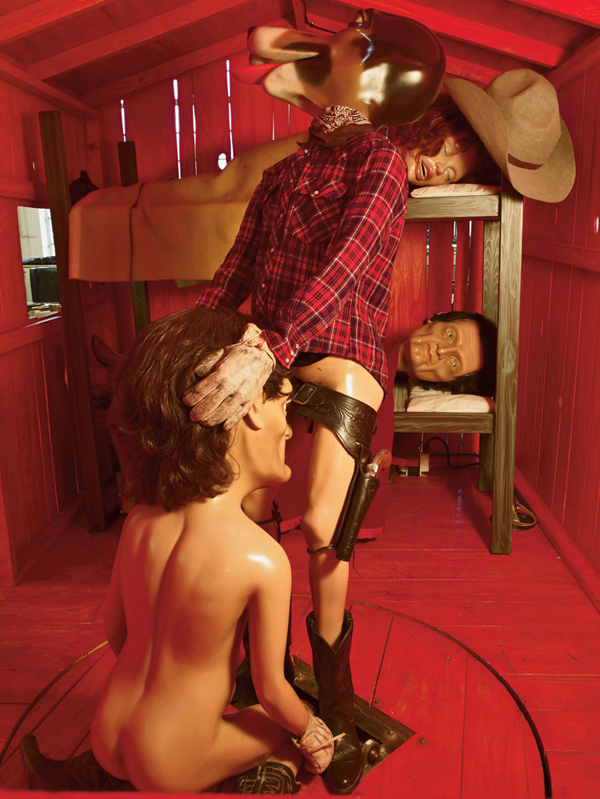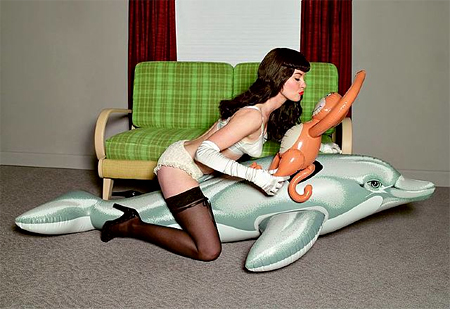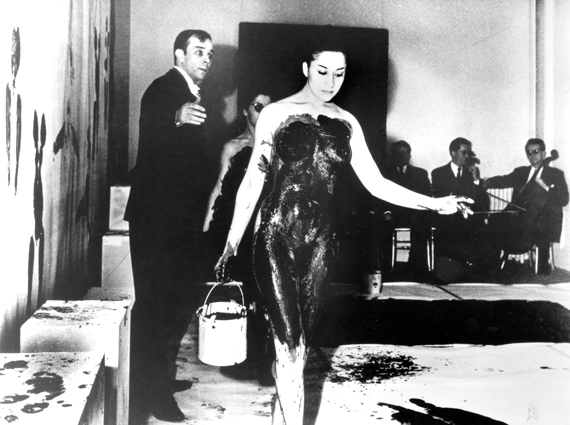Are we all part of the Society of the Spectacle, embedded and enmeshed in a vague relationship with internal and external reality all mediated by images, a series of disruptions with no coherent pattern giving us the impression of being social robots prodded along with small shocks that both alienate and create their own dependence. There is a certain sentiment that the world would fall apart, collapsing under the sum of its destructions should our commercial world be removed from us.

---Today commodification and reproduction are the only path to immortality -- the uniqueness that is unreproducible and thus transcendent. There will be neither works of art nor commodities in the future -- which may be here already -- but estheticized commodities -- commodities that represent the entertaining "world beyond," to refer to Debord’s term, and as such are eternally elite. Marx called religion the opium of the masses; esthetically entertaining commodities are the opium of the capitalist elite. What today we continue to call a work of art is simply a subclass of entertaining estheticized commodity. An estheticized commodity -- which is what capitalist society would like everything to become, whether something found in nature or made by human effort -- makes the old distinction between artworld and lifeworld, workworld and consumer world, obsolete.---Read More:http://www.artnet.com/magazineus/features/kuspit/art-and-capitalist-spectacle2-8-11.asp image:http://arttattler.com/commentarymccarthy.html
In a society of the spectacle ideology is publicity. A life of its own, publicity , publicity-ism has all the earmarks of an ideology, the ideology of the market, the buy and sell, the identity component the immediacy that can envelope and subsume religion, philosophy, esthetics, well beyond the simple conditioning of the consumer by sloganeering, but in all its subtleties representing a complete attitude to life as defined by the values and attributes of brand, the infinite quantification of anything that can be sold, taking ownership of almost all art and literature, transforming it and engineering consent with it.
Hollywood gets all the press, but advertising expenditures well surpass the investment of the entertainment complex. No contest. Its ability to permeate human perception both obviously, even crudely, and at unconscious levels, can lead to separating fantasy from reality a near impossibility; an exercise in psychological ordering, ideological self deception and a certain selling off or renting, for free, our individuality, then returning it to us substituted and disguised without the change being discernible. Perhaps this disparity is at the heart of modern alienation.

---But he didn’t like their reality, only their glamorized appearances. It was the kiss of death for esthetic experience and the ironic negation of Walter Benjamin’s theory that reproduction was socially progressive in that it eliminated the cultic aura art had in pre-modern -- pre-enlightened -- societies. As Warhol’s populist commercial art shows, reproduction serves the cult of the celebrity, whether it be a person or a product -- presents a person as a commercial product, and a commercial product as peculiarly personal, that is, with a crowd-pleasing personality. Two decades before Warhol’s crowd art, Benjamin’s theory was brought into critical question by Theodor Adorno’s theory of the culture industry -- a deliberate response to Benjamin grounded in the realities of capitalist Hollywood and mass culture. For Adorno, art is the victim of mechanical reproduction, and with that a mode of deception -- like all reproduction.---Read More:http://www.artnet.com/magazineus/features/kuspit/art-and-capitalist-spectacle2-8-11.asp image:http://weblog.404creative.com/2008/04/10/something-funky-art-and-photography-by-jeff-koons/
Where did this begin? The transition point was probably the image drenched society of the 1920′s, where the newish advertising industry began to understand the problems of selling more unnecessary goods in a marketplace by using the then technology of printing and radio, a change for the celebratory style that held some pretext of an underlying reason, functionality, even if the claims were preposterous.
There was a basis of individual representations for certain social values, far dissolved into our current mode where the dynamic of speed and fragmentation is antithesis and not conducive to thinking and reflection. It is the inducement of feeling and sensation and its hard to see where it can go from here. The commodity image system, now based on software generated profiles is having an indeterminant effect on the construction of consciousness, but at the same time “opting out” of the system is not readily apparent. Even so called “down-shifters” feel economically vulnerable.

---Yves Klein: With the Void, Full Powers at the Hirshhorn Museum is the artist’s first major retrospective in the United States in three decades. While Klein’s work has long been under-explored by American museums, his once radical ideas inspired many of the artistic movements of the last half century, such as minimalism, conceptual art and performance art. Although Klein’s career only lasted seven years (he died of a heart attack in 1962 at the age of 34), the artist produced an impressive body of work that explored how pure color, space and the body could be used to communicate immaterial spiritual truth.---Read More:http://calitreview.com/9415
We can look at the narrative of all commercial life as a perpetual monologue of events, the quality of the eternal, characters, even news events such as popular uprisings as part of this; all feelings and emotions without any coherent connecting theme as part of an overall sensorial scheme. And all our video images mirror this fragmentation of thought, competing to match us up with what we feel is the way we think. The routinization, normalization, even banalization of this speed-velocity- and fragmentation dynamic to the entire realm of culture increasingly indicates the new forms that thought are now taking. Judging it as good or bad is irrelevant, it will be what we do with it that will determine whether it can be made meaningful in our lives.








 COMMENTS
COMMENTS



